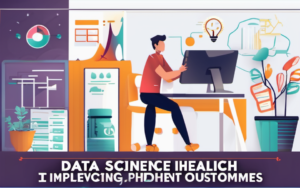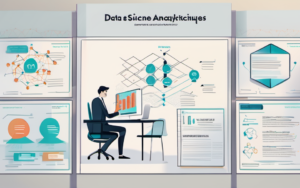The field of data science, as we know it today, is a relatively recent development. However, its roots lie deep in the past, built upon centuries of mathematical and statistical advancements, coupled with the revolutionary emergence of computing power. Understanding this history offers invaluable insights into the evolution of modern data science tools and techniques.
1. The Genesis of Data Science: Early Influences
1.1 Mathematics and Statistics: The Foundational Pillars
The very foundation of data science rests upon mathematics and statistics. Long before computers existed, mathematicians and statisticians were developing the theoretical frameworks and analytical methods that would later become the cornerstones of data science. The development of probability theory, statistical inference, and various mathematical models laid the groundwork for analyzing data and extracting meaningful insights. Early pioneers like Carl Friedrich Gauss and Pierre-Simon Laplace significantly contributed to the development of statistical methodologies that are still widely used today, even forming the base of modern machine learning algorithms. Their work provided the essential theoretical underpinnings for much of what we consider data science today.
1.2 Early Computing and the Rise of Algorithms
The invention of the computer drastically altered the landscape of data analysis. Early computers, while significantly less powerful than today’s machines, enabled the automation of complex calculations and the processing of larger datasets than ever before. This period saw the emergence of early programming languages specifically designed for numerical computation, marking a crucial step towards the development of specialized data science tools. The development of algorithms for sorting, searching, and statistical analysis became increasingly important, laying the groundwork for the efficient processing and analysis of data. The shift from manual calculations to automated processes through the use of early computers was a game-changer for statistical analysis, marking a significant turning point in the evolution of data science.
1.3 The Dawn of Data Visualization: Communicating Insights
Even in the early days of data science, the importance of effectively communicating insights derived from data was recognized. Early data visualization techniques, though limited by the technology available at the time, played a crucial role in presenting complex information in a more accessible and understandable format. The development of charts and graphs, often hand-drawn, allowed researchers to present their findings visually, thereby making them easier to grasp and interpret. Understanding the origins of statistical computing software and the historical development of data visualization techniques reveal the importance of effective communication in data analysis, a principle that remains central to data science today. This early emphasis on visual representation laid the foundation for the sophisticated visualization tools we use today.
2. Pioneering Techniques and Their Impact
2.1 Regression Analysis: Unveiling Relationships in Data
Regression analysis, a statistical method used to model the relationship between a dependent variable and one or more independent variables, emerged as a powerful tool in the early days of data science. This technique allowed researchers to explore and quantify relationships within data, paving the way for predictive modeling and forecasting. Early applications of regression analysis spanned diverse fields, from agriculture to economics, demonstrating its wide-ranging applicability. The development of linear regression models, in particular, served as a fundamental building block for more advanced techniques used in modern data science.
2.2 Classification Methods: Categorizing and Predicting
Classification methods, designed to assign data points to predefined categories, were another crucial development in early data science. Techniques such as decision trees and naive Bayes classifiers, while relatively simple compared to modern machine learning algorithms, allowed researchers to make predictions and categorize data based on learned patterns. These early classification techniques, though computationally simpler than their modern counterparts, were instrumental in solving various problems, laying the foundation for more sophisticated classification approaches widely used in various fields. This includes solving problems in areas like medical diagnosis and fraud detection.
2.3 Early Clustering Techniques: Grouping Similar Data Points
Clustering, the process of grouping similar data points together, gained prominence as a valuable exploratory data analysis technique. Early methods such as k-means clustering, despite their limitations, enabled researchers to uncover hidden structures and patterns within datasets. The use of clustering in early data science provided insights into the underlying relationships and structures within complex datasets, allowing for the identification of distinct groups or clusters. This helped in tasks like market segmentation and customer profiling, demonstrating the power of unsupervised learning in extracting valuable knowledge from data.
3. The Role of Key Figures and Discoveries
3.1 Influence of John Tukey and Exploratory Data Analysis
John Tukey, a highly influential statistician, championed the importance of exploratory data analysis (EDA). His emphasis on visually inspecting data and using intuitive methods to uncover patterns significantly shaped the approach to data analysis. Tukey’s contributions extended beyond EDA, encompassing significant advancements in robust statistical methods and the development of the fast Fourier transform, a cornerstone of modern signal processing. His influence permeates modern data science practices, highlighting the crucial role of thorough data exploration before employing more sophisticated modeling techniques.
3.2 The Contributions of Florence Nightingale and Data Visualization
Florence Nightingale, a pioneer in nursing and public health, is often considered one of the earliest users of data visualization for influencing policy. Her innovative use of charts and graphs to demonstrate the impact of sanitation on mortality rates in the Crimean War stands as a testament to the power of visual communication in conveying complex data. Nightingale’s work showcased the importance of visual representation in communicating data-driven insights to diverse audiences, highlighting the timeless relevance of data visualization in influencing decision-making processes.
3.3 Early Developments in Machine Learning Algorithms
The seeds of modern machine learning were sown in the early days of data science. Early algorithms, though computationally intensive, laid the foundation for many of the techniques used today. The development of perceptrons, early forms of artificial neural networks, and decision tree algorithms, while rudimentary by today’s standards, represented important milestones in the development of automated learning from data. These early algorithms, though limited by computing power, provided crucial insights into the potential of machine learning to automate data analysis and prediction.
4. Limitations and Challenges of Early Data Science
4.1 Computational Constraints and Data Storage
Early data scientists faced significant limitations in terms of computing power and data storage. The processing of large datasets was incredibly time-consuming, and storage capacity was severely restricted. This constraint limited the scale and complexity of the analyses that could be performed. These limitations necessitated creative approaches to problem-solving, often involving simplifying assumptions and focusing on smaller, more manageable datasets.
4.2 Data Scarcity and Quality Issues
Data scarcity was a major challenge in the early days of data science. The availability of large, high-quality datasets was limited, making it difficult to develop and validate sophisticated models. The quality of existing data was also often questionable, leading to challenges in data cleaning and preprocessing. These data limitations often required significant effort in data collection, cleaning and validation, highlighting the significant role of data quality in obtaining reliable results.
4.3 Interpretability and Explainability of Models
Early models, while often simple, were not always easily interpretable. Understanding why a model made a particular prediction could be challenging, limiting the ability to gain meaningful insights from the analysis. The focus shifted towards model accuracy often at the expense of model explainability, a challenge that remains relevant in the development and application of modern machine learning models. This emphasizes the importance of balancing predictive power with model transparency and understanding.
5. The Evolution and Legacy of Early Tools
5.1 Impact on Modern Data Science Practices
The early tools and techniques of data science have had a profound impact on modern practices. Many fundamental concepts and methods developed in the early days remain central to contemporary data science. Understanding the historical context of these early methods allows us to appreciate the challenges overcome and the innovations that led to today’s sophisticated tools and techniques. This historical perspective provides valuable insights into the foundational principles of the field.
5.2 Lessons Learned from Early Approaches
Studying the history of data science provides valuable lessons for today’s practitioners. The challenges faced by early data scientists highlight the importance of robust data quality, careful model selection, and the need for effective communication of results. Learning from past mistakes and successes can help prevent similar issues and foster innovation in the field. The early struggles with computational limitations, data quality issues, and model interpretability offer crucial lessons for current data scientists.
5.3 The Continued Relevance of Foundational Concepts
Despite the rapid advancements in technology and algorithms, many foundational concepts from early data science remain relevant today. The principles of statistical inference, exploratory data analysis, and the importance of clear communication are still central to the field. Understanding these foundational concepts provides a strong basis for navigating the complexities of modern data science and appreciating the evolution of the field. This enduring relevance underscores the timeless value of the fundamental principles established in the early days of data science.
The journey of data science, from its humble beginnings to its current prominence, is a testament to the ingenuity and perseverance of researchers and practitioners across numerous fields. The early tools, while limited by technology, laid the groundwork for the sophisticated techniques and technologies that we use today. By understanding this historical context, we can better appreciate the remarkable advancements and further the ongoing evolution of this transformative field.



